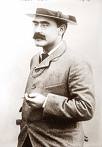Joseph Rudyard Kipling 1865 – 1936
December 15, 2008
 Joseph Rudyard
Kipling 1865 – 1936 was
an English author and poet. In 1907, he was awarded the Nobel Prize in
Literature,
making him the first English language writer to receive the prize, and
to date he remains its youngest
recipient.
Joseph Rudyard
Kipling 1865 – 1936 was
an English author and poet. In 1907, he was awarded the Nobel Prize in
Literature,
making him the first English language writer to receive the prize, and
to date he remains its youngest
recipient.
Among other honours, he was sounded out for the British Poet Laureateship and on several occasions for a knighthood, all of which he declined.
Rudyard Kipling called upon homeopath Fremont Hamilton to attend his daughter Josephine, as his wife, Carrie Balestier’s family were enthusiastic supporters of homeopathy (see below http://www.kipling.org.uk/rg_med_doctors1.htm Kipling and Medicine: Some of Kipling’s medical acquaintances by Gillian Sheehan).
Rudyard Kipling was a friend of Arthur Conan Doyle, Thomas Hardy, Henry James Jnr, Sarah Orne Jewett George Bernard Shaw, John Bland Sutton, Mark Twain, and Herbert George Wells and many famous people of his time.
Kipling wrote about homeopathy in Limits and Renewals:
From http://www.kipling.org.uk/rg_med_doctors1.htm Kipling and Medicine: Some of Kipling’s medical acquaintances by Gillian Sheehan C R Wilkett Also known as “Wilkie” or “Wilks”, he was the bacteriologist who played a major part in The Tender Achilles in Limits and Renewals… ’He was prepared to abide by my verdict because I knew Wilkie’s constitutional needs; and if I recommended homeopathic treatment, he would bow to that, too.’
From http://en.wikipedia.org/wiki/Rudyard_Kipling Rudyard Kipling was born on 30 December 1865 in Bombay, British India, to Alice Kipling and Lockwood Kipling. Alice Kipling… was a vivacious woman about whom a future Viceroy of India would say, “Dullness and Mrs. Kipling cannot exist in the same room.”
Lockwood Kipling, a sculptor and pottery designer, was the principal and professor of architectural sculpture at the newly founded Sir Jamsetjee Jeejeebhoy School of Art and Industry in Bombay.
The couple, who had moved to India earlier that year, met in courtship two years before at Rudyard Lake in Rudyard, Staffordshire, England, and had been so taken by its beauty that they now named their firstborn after it.
Kipling’s maternal aunt, Georgiana, was married to the painter Edward Burne Jones and his aunt Agnes was married to the painter Edward Poynter. His most famous relative was his first cousin, Stanley Baldwin, who was Conservative Prime Minister three times in the 1920s and 1930s…
The first decade of the 20th century saw Kipling at the height of his popularity. In 1907 he was awarded the Nobel Prize for Literature. The prize citation said: “in consideration of the power of observation, originality of imagination, virility of ideas and remarkable talent for narration which characterize the creations of this world-famous author.”
Nobel prizes had been established in 1901 and Kipling was the first English language recipient. At the award ceremony in Stockholm on 10 December 1907, the Permanent Secretary of the Swedish Academy, C.D. af Wirsén, praised both Kipling and three centuries of English literature:
The Swedish Academy, in awarding the Nobel Prize in Literature this year to Rudyard Kipling, desires to pay a tribute of homage to the literature of England, so rich in manifold glories, and to the greatest genius in the realm of narrative that that country has produced in our times.
“Book-ending” this achievement was the publication of two connected poetry and story collections: 1906’s Puck of Pook’s Hill and 1910’s Rewards and Fairies. The latter contained the poem ”If—”. In a 1995 BBC opinion poll, it was voted Britain’s favourite poem. This exhortation to self control and stoicism is arguably Kipling’s most famous poem.
Kipling sympathised with the anti Home Rule stance of Irish Unionists. He was friends with Edward Carson, the Dublin born leader of Ulster Unionism, who raised the Ulster Volunteers to oppose “Rome Rule” in Ireland. Kipling wrote the poem “Ulster” in 1912 (?) reflecting this. The poem reflects on Ulster Day (28 September 1912) when half a million people signed the Ulster Covenant.
Many have wondered why he was never made Poet Laureate. Some claim that he was offered the post during the interregnum of 1892-96 and turned it down. It also appears - surprisingly - that Queen Victoria disapproved of him…
Of interest:
Wolcott Balestier, Rudyard’s wife’s Carrie’s brother, was a friend of Edmund William Gosse, William Dean Howells and Henry James Jnr, who were intimately connected to several homeopaths.** **Two Balestier relatives were homeopaths in America in 1841.
Kipling’s uncle in law Edward Burne Jones was a close friend of George Eliot and Dante Gabriel Rossetti.
Kipling and his wife lived in Battleboro near the famous Battleboro Water Cure, where they would have met many homeopaths and homeopathic supporters, including Sarah Orne Jewett, Julia Ward Howe, Elizabeth Cady Stanton, Susan B. Anthony, Henry Ward Beecher, Laura Towne, Nathaniel Hawthorne, Lucretia Coffin Mott, Clemence Sophia Lozier, Elizabeth Stuart Phelps and Louisa May Alcott, John Greenleaf Whittier, and Harriet Beecher Stowe, and many others.
Of interest:
Charles Maurice Detmold and Edward Julius Detmold, twins, nephews of \*Edward Barton Shuldham, illustrated Lewis Carroll’s *Alice in Wonderland, Rudyard Kipling’s Jungle Book,